We get this question often. As you can see in this photo, we also repair a lot of laptops. While everyone loves the freedom and convenience of our small devices, this convenience comes at a cost. Many brand new laptops are made with older or inferior parts to keep margins down. Not only that, the laptop market is so flooded with seemingly great products that it’s difficult to weed through the choices.
When looking for a new laptop, you want to review a few main components of the computer to make sure you’re getting exactly what you need. You definitely don’t want to go with the cheapest machine available, but you don’t want to overpay either. This investment should last you 7-10 years so you want to spend some time researching a few key pieces of information.
Operating System
We recommend weeding out your internet search with the OS (operating system) first. While new operating systems can be fun, they don’t always get along with other devices and programs when they first launch. For this reason, we currently recommend beginning your search by looking for laptops that ship with Windows 10. Depending on which programs and services you need, Windows 11 could create more headaches for you than you’re prepared for.
CPU
The second item to review on a laptop is the processor or CPU. Oftentimes on laptops the CPU has been reduced in power to keep it from overheating. Another issue we see are older generations i.e. the newest model is 13th generation but the laptop has the older version from several years ago. A quick Google search can help you figure out how old the chip is.
RAM
The next order of business is RAM (Random Access Memory). We’ve noticed numerous laptops shipping with 8 GB of RAM. While that may be enough for casual web browsing, most people will want at least 16 GB to do anything beyond email and simple web surfing. You also want to check the type of RAM used and whether it’s upgradable or soldered to the motherboard. We recommend looking for the newer DDR4 RAM with the possibility to upgrade later on.
Hard Drive storage
After you’ve narrowed down your choices using the recommendations above, you should be left with just a few laptops that you need to compare. We recommend a 500 GB SSD (Solid State Drive), however if you’re into photos and video, definitely go for the larger 1 TB drive. We don’t recommend the SATA spinning drives since laptops are commonly being moved around.
External Ports
The last item to review are the external ports. Some manufacturers are removing ports in favor of a thinner profile which can be problematic. At a minimum, you’ll want to have 1 USB-C, at least 1 USB-A and a microphone/headset jack. You may need a USB extender if you have several devices, but they are easy to use. Lastly, you might want an ethernet port for hard wired internet and an HDMI port so you can connect another monitor.
We hope this helped answer the question of which laptop is best. If you still want help choosing, we are always here to help! Give us a call!







